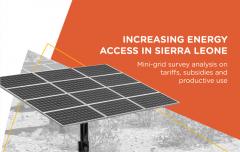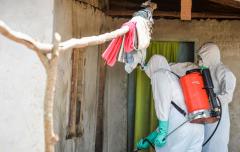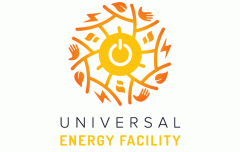Sierra Leone: Closing the energy access gap with mini-grids
- Sierra Leone has one of the lowest electricity access rates in the world: the national electrification rate is approximately 26 percent; however, this figure drops to only 6 percent in rural areas.
- To close the electricity access gap, mini-grids can present a least-cost solution while providing higher tiers of energy services.
To date, the development of mini-grids in Sierra Leone has been implemented under two donor-funded projects, of which the largest is the Rural Renewable Energy Project (RREP). This project aims to establish an enabling environment for a private sector-driven rural mini-grid market in the country, with the objective of supplying up to 5 MW of renewable electricity in rural communities. This would entail installations of at least 94 solar mini-grids to be operated and managed by private sector partners under public-private partnership agreements with the Ministry of Energy in Sierra Leone.
To build upon lessons learned from the ongoing Rural Renewable Energy Project and to explore ways for further expansion of the country’s mini-grid sector, Sustainable Energy for All (SEforALL) carried out a detailed assessment to provide practical guidance and recommendations to the Government of Sierra Leone and their development partners.
The report Increasing Energy Access in Sierra Leone, prepared by GreenMax Capital Advisors, also compares and highlights lessons learned from mini-grid sector development in Nigeria. Specifically, the report focuses on 1) mini-grid policy and regulatory environment (with a focus on tariffs and subsidies), 2) mini-grid productive use applications in the agricultural sector, and 3) mini-grid site selection criteria.
Mini-grid policy and regulatory environment
To make the mini-grid business models economically viable, it is necessary to improve the affordability of mini-grid electricity tariffs, and thus increase the connection rates of new customers as well as increase productive consumption of existing customers.
Flexible subsidy mechanisms, such as an up-front cash grant/results-based financing hybrid scheme (as opposed to an ‘in-kind’ subsidy) could be explored to further reduce project costs and potentially lower tariffs. This hybrid structure would reduce developers’ up-front capital constraints while also ensure quality of service as developers are fully paid based on the deployment and verification of the connections. The value of the subsidy should be high enough to achieve tariff reduction.
It is important to emphasize that although the mini-grid tariff in Sierra Leone might be considered unaffordable by many, a large number of mini-grid customers had never used electricity in this form prior to the arrival of the mini-grid and ended up consuming more electricity than they could afford.
Significant public and private sector resources should therefore focus on community sensitization, consumer education, and training around electricity usage and expenditures, energy efficiency, mini-grid load capacity, appliance usage, productive use of energy (PUE), and other benefits and cost savings of mini-grid electrification. As consumer awareness around energy usage and expenditures improves over time, mini-grid usage can be further optimized.
Productive use of energy
In Sierra Leone, most of the population lives in rural areas and engages in subsistence agriculture. The demand and ability to pay for electricity from mini-grids among these rural agrarian communities are highly dependent upon the seasonality of income, crop yield, etc. Mini-grids can power rural agricultural productive activities and create new businesses or expand existing ones linked to the agricultural value chain. This makes the PUE a critical tool going forward, as it can provide a steadier source of income and help increase the purchasing power of communities in the long term, building an anchor demand for mini-grid projects and creating a virtuous cycle of electrification and economic growth.
Therefore, it is important to develop and implement programmes providing technical and financial support to mini-grid developers to stimulate PUE and revenue-generating activities in mini-grid communities, which provide anchor clients for mini-grid power supply and increase customer income levels and purchasing power.
Rolling out PUE in mini-grid communities on a large scale will require extensive coordination across various public agencies (e.g., Ministry of Energy, Ministry of Agriculture and Forestry, Ministry of Planning and Economic Development, Ministry of Local Government and Rural Development), as well as private sector support, including from the local financial sector (e.g., Sierra Leone Association of Microfinance Institutions) to improve access to local currency financing for the sector and consumers.
Mini-grid site selection
In Sierra Leone, the RREP beneficiary communities were selected based on the following criteria: 1) existence of a community health centre; 2) size of the community with respect to households, businesses and population density; 3) distance of the community to the health centre; and 4) distance of the community to any existing or planned transmission lines and/or the existence or plan for any other electrification project. The selection criteria prioritized supplying electricity to the community health centres and gave less emphasis on demand-side considerations for Work Package 1 sites [1]. In contrast, Work Package 2 [2] focused more on PUE opportunities.
To support the site selection process for future large-scale interventions, it is recommended to utilize GIS/georeferenced data and other consumer and market intelligence tools and to include both supply-side and demand-side needs assessment. For example, in Nigeria, the Rural Electrification Agency implemented a national data management platform (Odyssey) that provides information to developers (e.g., demand forecasting, tariff calculation etc.) to help streamline project development and improve customer demand estimation and avoid power underutilization.
These recommendations and more can be found in greater detail in the report Increasing Energy Access in Sierra Leone.
Funding support for the report was provided by the UK’s Foreign, Commonwealth & Development Office (FCDO) and administrative support came from the United Nations Office for Project Services (UNOPS) in Sierra Leone.
-------------
[1] The Work Package 1 (WP-1) involved the installation of 16 - 36 kWp solar generation systems in 50 community health centres as pilot sites in 14 districts across Sierra Leone.
[2] Under Work Package 2 (WP-2), three private sector companies bid and negotiated public-private partnership agreements with the Ministry of Energy to operate the existing mini-grid systems installed under WP-1 and WP-1+ and to co-invest in the electrification of an additional 44 rural communities with mini-grids ranging in size from 36 kWp to 200 kWp.




